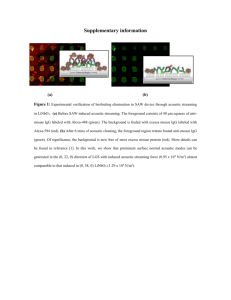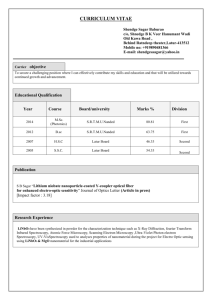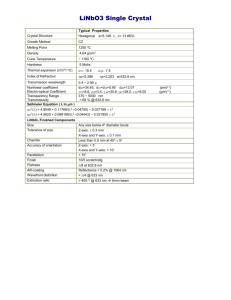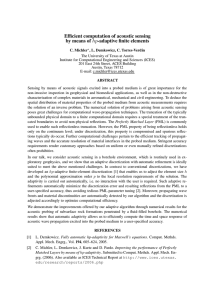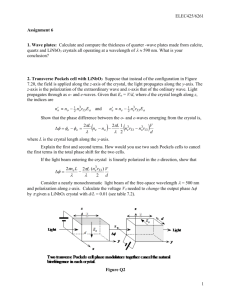Finite Element Analysis of Y+41 LiNbO Based on
advertisement
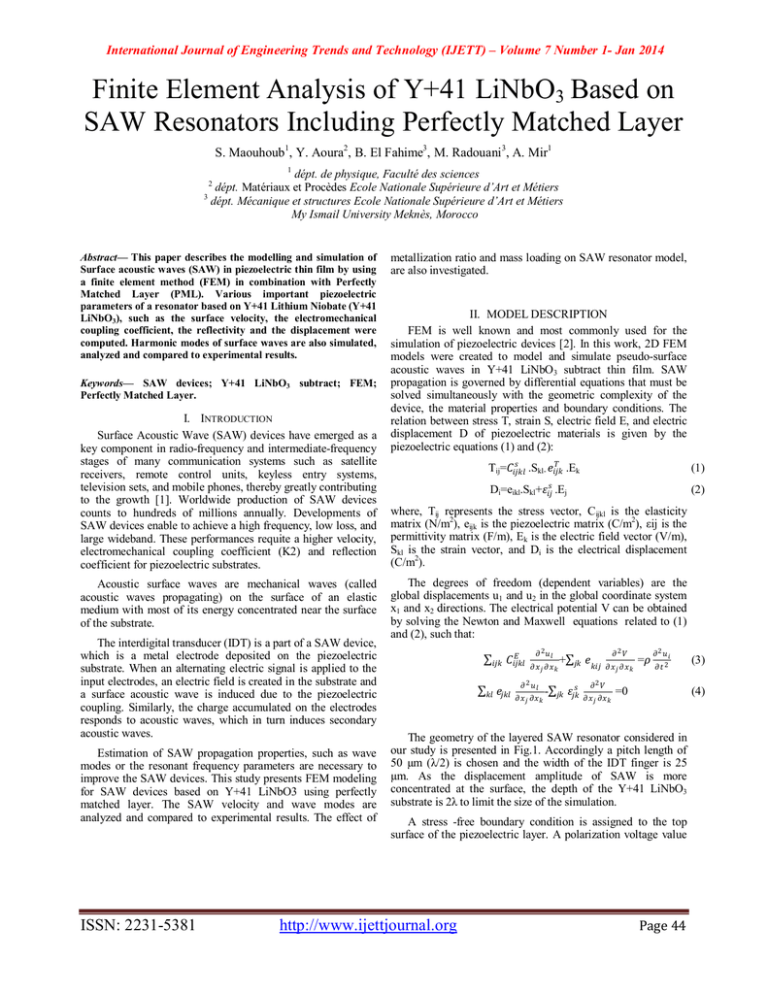
International Journal of Engineering Trends and Technology (IJETT) – Volume 7 Number 1- Jan 2014 Finite Element Analysis of Y+41 LiNbO3 Based on SAW Resonators Including Perfectly Matched Layer S. Maouhoub1, Y. Aoura2, B. El Fahime3, M. Radouani3, A. Mir1 1 dépt. de physique, Faculté des sciences dépt. Matériaux et Procèdes Ecole Nationale Supérieure d’Art et Métiers 3 dépt. Mécanique et structures Ecole Nationale Supérieure d’Art et Métiers My Ismail University Meknès, Morocco 2 Abstract— This paper describes the modelling and simulation of Surface acoustic waves (SAW) in piezoelectric thin film by using a finite element method (FEM) in combination with Perfectly Matched Layer (PML). Various important piezoelectric parameters of a resonator based on Y+41 Lithium Niobate (Y+41 LiNbO3), such as the surface velocity, the electromechanical coupling coefficient, the reflectivity and the displacement were computed. Harmonic modes of surface waves are also simulated, analyzed and compared to experimental results. Keywords— SAW devices; Y+41 LiNbO3 subtract; FEM; Perfectly Matched Layer. I. INTRODUCTION Surface Acoustic Wave (SAW) devices have emerged as a key component in radio-frequency and intermediate-frequency stages of many communication systems such as satellite receivers, remote control units, keyless entry systems, television sets, and mobile phones, thereby greatly contributing to the growth [1]. Worldwide production of SAW devices counts to hundreds of millions annually. Developments of SAW devices enable to achieve a high frequency, low loss, and large wideband. These performances requite a higher velocity, electromechanical coupling coefficient (K2) and reflection coefficient for piezoelectric substrates. Acoustic surface waves are mechanical waves (called acoustic waves propagating) on the surface of an elastic medium with most of its energy concentrated near the surface of the substrate. The interdigital transducer (IDT) is a part of a SAW device, which is a metal electrode deposited on the piezoelectric substrate. When an alternating electric signal is applied to the input electrodes, an electric field is created in the substrate and a surface acoustic wave is induced due to the piezoelectric coupling. Similarly, the charge accumulated on the electrodes responds to acoustic waves, which in turn induces secondary acoustic waves. Estimation of SAW propagation properties, such as wave modes or the resonant frequency parameters are necessary to improve the SAW devices. This study presents FEM modeling for SAW devices based on Y+41 LiNbO3 using perfectly matched layer. The SAW velocity and wave modes are analyzed and compared to experimental results. The effect of ISSN: 2231-5381 metallization ratio and mass loading on SAW resonator model, are also investigated. II. MODEL DESCRIPTION FEM is well known and most commonly used for the simulation of piezoelectric devices [2]. In this work, 2D FEM models were created to model and simulate pseudo-surface acoustic waves in Y+41 LiNbO3 subtract thin film. SAW propagation is governed by differential equations that must be solved simultaneously with the geometric complexity of the device, the material properties and boundary conditions. The relation between stress T, strain S, electric field E, and electric displacement D of piezoelectric materials is given by the piezoelectric equations (1) and (2): Tij= .Skl- Di=eikl.Skl+ .Ek (1) .Ej (2) where, Tij represents the stress vector, Cijkl is the elasticity matrix (N/m2), eijk is the piezoelectric matrix (C/m2), εij is the permittivity matrix (F/m), Ek is the electric field vector (V/m), Skl is the strain vector, and Di is the electrical displacement (C/m2). The degrees of freedom (dependent variables) are the global displacements u1 and u2 in the global coordinate system x1 and x2 directions. The electrical potential V can be obtained by solving the Newton and Maxwell equations related to (1) and (2), such that: 2 ∑ ∑ 2 +∑ 2 2 = 2 2 -∑ =0 (4) The geometry of the layered SAW resonator considered in our study is presented in Fig.1. Accordingly a pitch length of 50 µm (λ/2) is chosen and the width of the IDT finger is 25 µm. As the displacement amplitude of SAW is more concentrated at the surface, the depth of the Y+41 LiNbO3 substrate is 2λ to limit the size of the simulation. A stress -free boundary condition is assigned to the top surface of the piezoelectric layer. A polarization voltage value http://www.ijettjournal.org (3) Page 44 International Journal of Engineering Trends and Technology (IJETT) – Volume 7 Number 1- Jan 2014 of 1V is applied to the aluminum electrode, which has a thickness of 1µm. Calling conditions to quasi-periodic boundary on the left and periodic boundary law, namely ΓL and ΓR, we can limit the computational domain to a single cell unit. Perfectly matched layers (PMLs) for SAW devices are used in the finite element method (FEM). A PML is an absorbing boundary condition for truncating the computational domain of open regions without reflection of incident waves [3]. In this study the PML condition is applied at the bottom of the substrate Figure 2. Total displacement profile showing acoustic wave mode shapes (a)Rayleigh wave mode resonance at 47 MHz (b) Rayleigh wave mode antiresonance at 48 MHz. B. Harmonic analysis 1) Effect of PML: In order to study the effect of PML domain on the SAW resonator, two simulations are carried out with and without PML condition. Figure 1. Geometry employed for a periodic cell in the simulation. To calculate the transformed matrices for differing crystal cuts, we used the procedure called transformation of coordinates. The procedure is explained in detail in [4]. A separate program was written in MATLAB software for the matrices transformation of the Y+41 LiNbO3 subtract which were then introduced in the FEM. Fig.3 shows the variation of the imaginary part of admittance in case of with and without PML boundary condition. The resonant frequency fr for Y+41 LiNbO3 substrate calculated on presence of PML condition is 47MHz, which is similar to the experiments results [5]. The results show that in the model without PML, the resonant frequency is far from the literature result [6]. We can note that the better accuracy of results is obtained using FEM including PML boundary condition. Two analysis types are used to investigate the Y+41 LiNbO3 SAW resonators: Modal analysis to investigate the frequencies and mode of deformation. Harmonic analysis to steady state response from harmonic excitation within the desired bandwidth of 20MHz to 70MHz. Eigen III. RESULTS AND DISCUSSION A. Modal analysis Initially Eigen frequency analysis is performed for the SAW resonator and total displacement profile is investigated. Several peaks were found and flexural modes were identified at 47MHz and 48MHz. The Fig.2 gives the total displacement profile showing acoustic wave mode shapes. ISSN: 2231-5381 Figure 3. Imaginary part of electric admittance with an without PML conditions. 2) Characteristics parameters of SAW devices: The performance of SAW devices depend to the velocity, the electromechanical coupling coefficient K2 and the reflectivity per electrode of piezoelectric substrates [7, 8]. A modal analysis is performed which gives two Eigen http://www.ijettjournal.org Page 45 International Journal of Engineering Trends and Technology (IJETT) – Volume 7 Number 1- Jan 2014 frequencies (fa and fr) that are the edges of the stopband. Since there is no propagation into the media in this band of frequencies, the velocity is determined from the pair (of Eigen frequencies) using the equation (5): Vfrfa p (5) C. Performance of the SAW resonator: The parameters enable to control the center frequency and the performance of SAW resonator are the metallization ratio (MR) and electrode height (EH). They are represented as follow: (8) The electromechanical coupling coefficient K2 and the reflectivity per electrode can be calculated using equations (6) and (7): (9) K2= (6) r=2π (7) electrode height on the imaginary part of the admittance for where, a is the width of the electrode, p is the period of the structure and h is the height of the electrode. Fig.5 and Fig.6 show the effect of metallization ratio and where, v is the velocity, fr, fa are the resonant and anti resonant frequency , R[Y(fr)] and Im[Y(fr)] are the real and imaginary part of electric admittance at resonant frequency respectively, N is the number of fingers and r is the reflectivity. The harmonic analysis is performed which gives the admittance. The application of an electrical potential provides the variation of the real and imaginary part of the admittance with frequencies values (see Fig.4). Y+41 LiNbO3. The value of the center frequency increases with the decrease of the MR and the height of the electrodes. In addition, the bandwidth of the devices remains approximately constant with the variation of the electrodes height or metallization ratio. Figure 4. The real and imaginary part of electric admittance for Y+41 LiNbO3 SAW resonator. From Fig.4, we extracted resonant and anti-resonant frequencies to compute the values of V, K2 and r shown in Table I. TABLE I. Figure 5. Evolution of the imaginary part of the admittance as a function of MR for Y+41 LiNbO3, EH=1% CHARACTERISTICS PARAMETERS FOR Y+41 LINBO3 SAW RESONATOR Velocity(m/s) K2(%) R Literature[5] Experimental[4] Simulation 4790 17.3 - 4275 18.8 -0.003 4750 18.7 -0.06 From Table I, we find that the velocity and the electromechanical coupling coefficient are consistent with results of previous studies, which validates the proposed model. In addition, the reflectivity has a negative value because the resonant frequency fr is smaller than the antiresonant frequency fa. ISSN: 2231-5381 Figure 6. Evolution of the imaginary part of the admittance as a function of EH for Y+41 LiNbO3 , MR= 0.5 http://www.ijettjournal.org Page 46 International Journal of Engineering Trends and Technology (IJETT) – Volume 7 Number 1- Jan 2014 IV. CONCLUSIONS In this paper, a detailed Finite Element analysis is carried out for Y+41 LiNbO3 SAW resonators to observe the piezoelectric effect and the frequency response. The FEM including Perfectly Matched Layer boundary condition is well suited for a better prediction of the resonance frequencies through simulations. Indeed, the effect of the metallization ratio and electrode height is investigated. It was shown that the performance of the SAW resonator depends of previous parameters. The simulation results have a good consistent with results of previous studies. REFERENCES [1] [2] [3] [4] [5] [6] [7] [8] T.Kannan "Finite Element Analysis of Surface Acoustic WaveResonators",2006. D. Karim, S. Ballandras, T. Laroche, K. Wagner, J. Brice, X. Perois; Finite Element Analysis of Y+41 LiNbO3 Based SAW Resonators Including Perfectly Matched Layer. Applied Mathematics, 2013, 4, 6471 K.J. Bathe, “Finite Element Procedures”, New Jersey: Prentice Hall, 1996. B.A. Auld, “Acoustic Fields and Waves in Solids,” vol. 1. Malabar, Florida:Robert E. Krieger Publishing Company, 2 ed., 1990. Eric L. Adler "SAW and PSAW Properties Using Matrix Methods," lEEETransactions on Ultraonics Ferroelectrics and Frequency control, Vol.41N°6(1994)pp876-887. M.El Hakiki "Etude theorique et experimentale de dispositifs à ondes élastiques de surface (O.E.S) à bases de structures multicouches : ZnO/Quartz,AIN/Diamant et ZnO/AIN/Diamant," 2005. V. Plessky and J. Koskela, “Coupling-of-Modes Analysis of SAW Devices,” International Journal of High Speed Electronics and Systems, vol.10,no.4,pp.867–947,2000. J. H. Hines and D. C. Malocha "A simple Transducer Equivalent Circuit Parameter Extraction Technique," Ultrasonics Symposium, 1993, pp 173-17 ISSN: 2231-5381 http://www.ijettjournal.org Page 47
